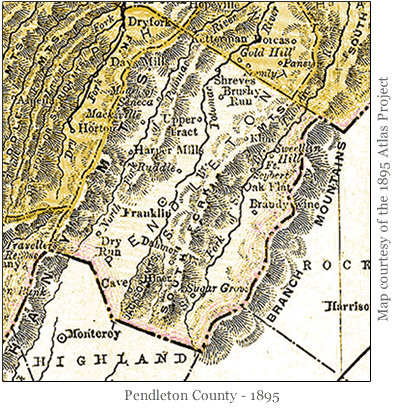|
Moderated by NW Okie! |
Volume 14 , Issue 422012Weekly eZine: (366 subscribers)Subscribe | Unsubscribe Using Desktop... |
Pendleton County, (West) Virginia - 1910-1912

The inhabitants of Pendleton county, West Virginia were/are the posterity of its pioneer settlers. This was said back in 1912 for this reason: that Pendleton is not an unbroken expanse of smooth, fertile land. It was also written the rural community is always the feeder of the city and the town, and Pendleton will remain predominantly rural.
Improved transit would open the way to a fuller utilization of the material resources of the county and to a greater diversification of the products of the farm. The broader opportunities would attract new people, while on the other hand they would keep at home a larger share of the native population.
A larger number of summer guests would come to enjoy the mountain air and to view the scenic attractions. The county would grow more wealthy, and the closer contact with city standards would cause a falling away from the freedom and spontaneity of the old-time country life.
The contour of Pendleton, with its population massed in narrow valleys, was exceptionally favorable to a system of central schools.
The Pendleton farmer had to grow nearly all his supplies, simply because no other course was open to him. With the railroad once at his door it would become less necessary to raise crops that he now produces at a disadvantage. The rich bottoms would remain in tillage, but tot he production in part of what are now esteemed the minor products of the farm. The hills would be given chiefly to grazing. For beef, mutton, wool, and dairy products, the position of the Appalachian highland was increasingly secure.
commercial fruit culture would also become possible. New orchards would appear in the least frosty localities. Poultry would likewise become more profitable. Along with a more diversified agriculture would come more scientific and more remunerative methods.
The mines of America had a per capita output of $22 in 1912. Pendleton's iron ores alone, according to the conservated estimate of expert authority, were capable of maintaining its share for a century and a half, as reported back in the early 1900's.
Pendleton county was naturally designed as a forest reserve. Soil and climate were highly favorable to the growth of wood, and a very large proportion of its surface could not profitably be cleared. They should be so looked after as to yield a large and regular supply of fuel and lumber. It was reported back in 1912 that the nation had been reckless and wasteful with its timber supply, and the process had gone to such a length that even a temporary famine in timer was inevitable in the near future. Stern necessity was compelling the American people to resort to systematic forestry on a large scale, and to take lessons in this matter from Germany, France and Japan.
Trees like the walnut, for which Pendleton soil was well suited, had a secondary value as producers of nuts.
| View or Add Comments (0 Comments)
| Receive
updates ( subscribers) |
Unsubscribe
| © . Linda Mcgill Wagner - began © 1999 Contact Me | |
